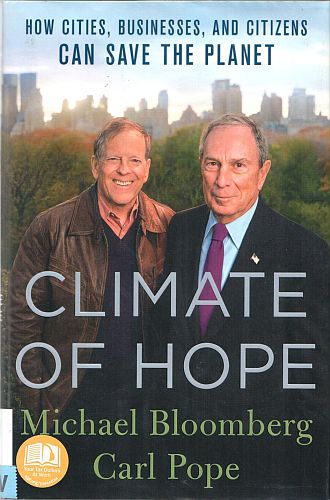

| CLIMATE OF HOPE How Cities, Businesses, and Citizens Can Save the Planet Michael Bloomberg Carl Pope New York: St. Martin's Press, April 2017 |
Rating: 5.0 High |
|||
| 978-1-250-14207-8 | ||||
| ISBN 1-250-14207-5 | 264pp. | HC/FCI | $26.99 | |
That Michael Bloomberg teamed up with Carl Pope to collaborate on this book might seem an unlikely alliance. A hedge-funder working with a tree-hugger? But that view relies on stereotyping both men — and also on promoting the view that fixing the environment is, financially, always a losing proposition.1 Corporations typically seek to promote both stereotypes to a degree — branding environmentalists as impractical dreamers at best, out to sabotage commerce at worst; and portraying every pollution-control measure as ruinously expensive — but moreso the latter as it does not demonize people. Hurling epithets like "commie" or "eco-Nazi" often comes across as bullying, given the advantage the corporations have in power.2
But in fact there is a great synergy in their alliance. Carl Pope brings a long history of successes as director of the Sierra Club, culminating in their Beyond Coal operation.3 Michael Bloomberg's contribution was his experience as a financier. The motivation for their alliance — and for this book — was the realization that people respond better to opportunities presented by climate change they can claim today than to warnings of a future crisis (however well-supported and circumspect) that climate change will bring.
Along with describing again the basic facts of climate science, they do a masterful job of showing us what those opportunities are. (I go into some depth on them in the page linked below.) To put it briefly, responding to the challenge of climate change can give us:
All these changes, of course, will also make for a healthier environment — which means we will be healthier too. But there is a downside: most of these changes involve a large up-front cost. An electric vehicle, for example, costs more to buy than a conventional one. A rooftop solar array is a big investment for most homeowners. These are genuine obstacles, and the authors delve into some ways to get around them. One is leasing that solar array. Not only does this remove a burden from the original installer, but it simplifies the resale of the house.
The book is well written and conveys a great deal of information. It includes 31 color images, some of which are biographical in nature while others depict charts and graphs. Bloomberg and Pope contributed different chapters, though not in strict alternation. There are few errors. The main defects of the book are that it appears somewhat cursory in its treatment of some areas (presumably because it was written by two very busy men) and that it lacks an index. For those reasons I don't consider it a keeper. But I do recommend it and mark it at the top. It adds significantly to the body of literature that shows us the worth of acting now to lower carbon emissions.
Mitigating climate change and moving to a low-carbon economy will be an investment-intensive effort that presents opportunities both for savings and for economic growth. The capitalists who seek to stay stuck in a fossil fuel past forget that progress is its own economic stimulus. – Page 199 |

 To contact Chris Winter, send email to this address.
To contact Chris Winter, send email to this address.